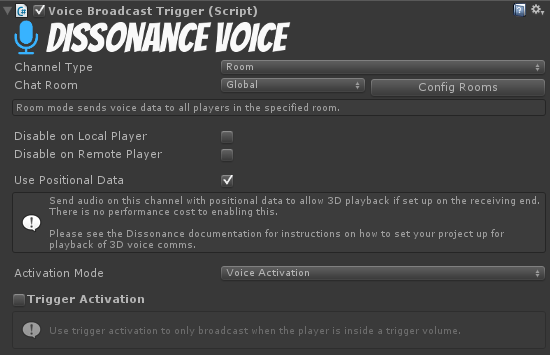TNet3
This Quick Start guide is for those of you integrating Dissonance into a game with the TNet3 asset.
This integration requires Dissonance 6.4.2 or greater.
This tutorial will guide you through the steps required to get a basic Dissonance setup working in your project. By the end of this tutorial, you will having working voice comms with all users talking in a global chat room.
Before beginning this tutorial, please refer to the installation guide to learn how to install Dissonance into your project.
A demo scene for this tutorial can be found in the Assets/Dissonance/Integrations/TNet3/Demo folder.
Step 1: Dissonance Comms Object⚓︎
Dissonance runs mostly from a single game object, which should be placed somewhere near the root of your scene. This object contains the main "Dissonance Comms" behaviour, together with the TNet3 networking script.
To place the default Dissonance object into your scene, drag and drop the DissonanceSetup prefab from the Dissonance/Integrations/TNet3 folder into your scene.
Once you have instantiated the DissonanceSetup prefab, you should have an object with two scripts attached: Dissonance Comms and Tnet3 Comms Network.
Step 1a: Network Channel Setup⚓︎
A single TNet3 server hosts multiple channels at once, players can only send and receive packets to channels they have joined. The Dissonance integration automatically hosts a voice session in a separate channel - this means you can potentially host multiple completely independent voice chat sessions on a single TNet3 server. Once your game is started you need to choose which voice session to host/join for each peer that connects:
To begin hosting a new session in a channel:
var tcnc = FindObjectOfType<TasharenCommsNetwork>();
tncn.HostVoiceChannel(channel_id, max_players, "password", is_dedicated_server);
This will begin hosting a new Dissonance voice chat session in the channel identified by channel_id. If is_dedicated_server is true then the local instance will not be able to send or receive audio - it is simpl acting as a network host.
To join an existing session:
var tcnc = FindObjectOfType<TasharenCommsNetwork>();
tcnc.JoinVoiceChannel(channel_id, "password");
This will attempt to join a session in the specified channel_id.
These methods can be called again at any time to change the mode of Dissonance.
Step 2: Add a Broadcast Trigger⚓︎
You now have a functional Dissonance comms system, but you are not yet transmitting anything.
Before you can speak to anyone, you need to add a "Voice Broadcast Trigger" script to the scene. This script can be placed anywhere, but for this tutorial, you should simply add it to the DissonanceSetup game object you created in step 1.
The "Voice Broadcast Trigger" controls when the user's microphone is being transmitted to other players, and to whom the user is talking. There are many configuration options on this script to provide more advanced control of under what situations we should be transmitting and who to, but for this tutorial simply leave the settings at default.

To set up the broadcast trigger, change the following two settings: 1. Transmit on Voice Activation. This means Dissonance will transmit whenever it detects that the user is speaking. 2. Transmit to the 'Global' chat room.
Step 3: Add a Receipt Trigger⚓︎
Now you are talking into the 'Global' room automatically whenever you speak. However, you still can't hear anyone speaking. This is because you are not listening to the 'Global' room and so you are not receiving any of these transmissions.
To listen to the 'Global' room, add a "Voice Receipt Trigger" to the scene. Like the "Voice Broadcast Trigger", this script can be placed anywhere, but for this tutorial you should simply add it to the DissonanceSetup game object.

Again, leave this on the default configuration, which should have trigger activation disabled and be listening to the 'Global' chat room.
You're Done!⚓︎
Congratulations, you have now added voice comms to your game! What to do next?